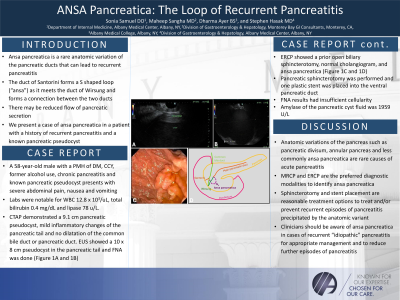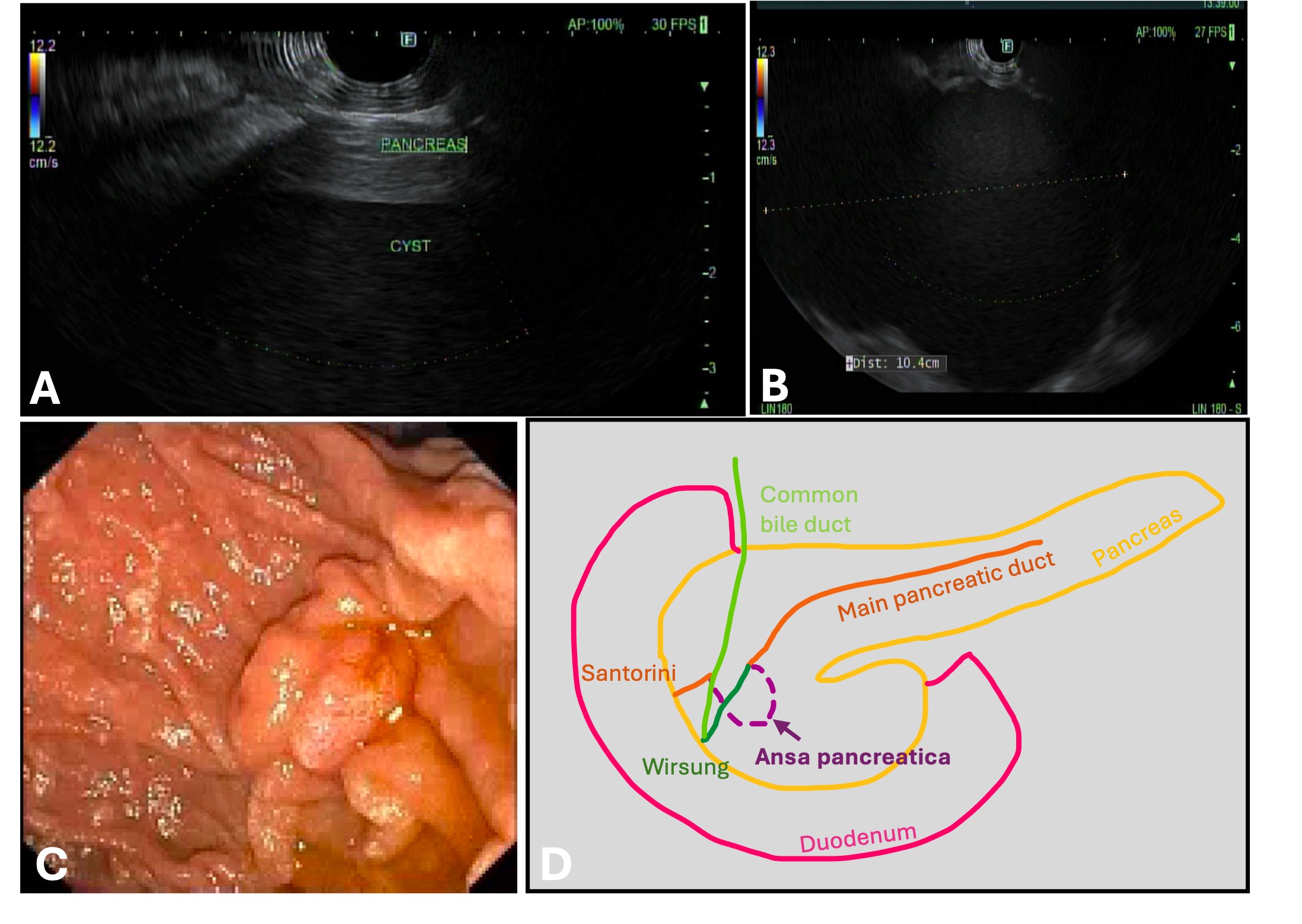Monday Poster Session
Category: Biliary/Pancreas
P1885 - ANSA Pancreatica: The Loop of Recurrent Pancreatitis
Monday, October 28, 2024
10:30 AM - 4:00 PM ET
Location: Exhibit Hall E

Has Audio
- SS
Sonia Samuel, DO
Albany Medical Center
Albany, NY
Presenting Author(s)
Sonia Samuel, DO1, Maheep Sangha, MBBS1, Dharma Ayer, BS1, Stephen Hasak, MD, MPH2
1Albany Medical Center, Albany, NY; 2Albany Medical College, Albany, NY
Introduction: Ansa pancreatica is a rare anatomic variation of the pancreatic ducts that can lead to recurrent pancreatitis. The duct of Santorini forms a S shaped loop (“ansa”) as it meets the duct of Wirsung and forms a connection between the two ducts. As a result, there may be reduced flow of pancreatic secretion. We present a case of ansa pancreatica in a patient with a history of recurrent pancreatitis and a known pancreatic pseudocyst.
Case Description/Methods: A 58-year-old male with a past medical history of diabetes mellitus, cholecystectomy, former alcohol use, and chronic pancreatitis with known pancreatic pseudocyst presents with severe abdominal pain, nausea and vomiting. He denied recent alcohol use. Labs at presentation were notable for WBC 12.8 x 103/uL, total bilirubin 0.4 mg/dL and lipase 78 u/L. Computed tomography (CT) of the abdomen and pelvis demonstrated a 9.1 cm pancreatic pseudocyst, mild inflammatory changes of the pancreatic tail and no dilatation of the common bile duct or pancreatic duct. Endoscopic ultrasound (EUS) showed a 10 x 8 cm pseudocyst in the pancreatic tail and fine-needle aspiration (FNA) was done (Figure 1A and 1B). Cystogastrostomy was not performed due to a thin portion of pancreas between the stomach and cyst. Endoscopic retrograde cholangiopancreatography (ERCP) showed a prior open biliary sphincterotomy, normal cholangiogram, and ansa pancreatica (Figure 1C and 1D). Pancreatic sphincterotomy was performed and one plastic stent was placed into the ventral pancreatic duct. FNA results had insufficient cellularity. Amylase of the pancreatic cyst fluid was 1959 U/L.
Discussion: Anatomic variations of the pancreas such as pancreatic divisum, annular pancreas and less commonly ansa pancreatica are rare causes of acute pancreatitis. The diagnosis may be incidental or in those who present with recurrent episodes of pancreatitis. Magnetic resonance cholangiopancreatography (MRCP) and ERCP are the preferred diagnostic modalities to identify ansa pancreatica when symptoms result. Sphincterotomy and stent placement are reasonable treatment options to treat and/or prevent recurrent episodes of pancreatitis precipitated by the anatomic variant. Clinicians should be aware of ansa pancreatica in cases of recurrent “idiopathic” pancreatitis for appropriate management and to reduce further episodes of pancreatitis.

Disclosures:
Sonia Samuel, DO1, Maheep Sangha, MBBS1, Dharma Ayer, BS1, Stephen Hasak, MD, MPH2. P1885 - ANSA Pancreatica: The Loop of Recurrent Pancreatitis, ACG 2024 Annual Scientific Meeting Abstracts. Philadelphia, PA: American College of Gastroenterology.
1Albany Medical Center, Albany, NY; 2Albany Medical College, Albany, NY
Introduction: Ansa pancreatica is a rare anatomic variation of the pancreatic ducts that can lead to recurrent pancreatitis. The duct of Santorini forms a S shaped loop (“ansa”) as it meets the duct of Wirsung and forms a connection between the two ducts. As a result, there may be reduced flow of pancreatic secretion. We present a case of ansa pancreatica in a patient with a history of recurrent pancreatitis and a known pancreatic pseudocyst.
Case Description/Methods: A 58-year-old male with a past medical history of diabetes mellitus, cholecystectomy, former alcohol use, and chronic pancreatitis with known pancreatic pseudocyst presents with severe abdominal pain, nausea and vomiting. He denied recent alcohol use. Labs at presentation were notable for WBC 12.8 x 103/uL, total bilirubin 0.4 mg/dL and lipase 78 u/L. Computed tomography (CT) of the abdomen and pelvis demonstrated a 9.1 cm pancreatic pseudocyst, mild inflammatory changes of the pancreatic tail and no dilatation of the common bile duct or pancreatic duct. Endoscopic ultrasound (EUS) showed a 10 x 8 cm pseudocyst in the pancreatic tail and fine-needle aspiration (FNA) was done (Figure 1A and 1B). Cystogastrostomy was not performed due to a thin portion of pancreas between the stomach and cyst. Endoscopic retrograde cholangiopancreatography (ERCP) showed a prior open biliary sphincterotomy, normal cholangiogram, and ansa pancreatica (Figure 1C and 1D). Pancreatic sphincterotomy was performed and one plastic stent was placed into the ventral pancreatic duct. FNA results had insufficient cellularity. Amylase of the pancreatic cyst fluid was 1959 U/L.
Discussion: Anatomic variations of the pancreas such as pancreatic divisum, annular pancreas and less commonly ansa pancreatica are rare causes of acute pancreatitis. The diagnosis may be incidental or in those who present with recurrent episodes of pancreatitis. Magnetic resonance cholangiopancreatography (MRCP) and ERCP are the preferred diagnostic modalities to identify ansa pancreatica when symptoms result. Sphincterotomy and stent placement are reasonable treatment options to treat and/or prevent recurrent episodes of pancreatitis precipitated by the anatomic variant. Clinicians should be aware of ansa pancreatica in cases of recurrent “idiopathic” pancreatitis for appropriate management and to reduce further episodes of pancreatitis.

Figure: Figure 1A and 1B- Endoscopic ultrasound of pancreatic pseudocyst. 1C- Upper endoscopy of ansa pancreatica 1D- Anatomy of ansa pancreatica
Disclosures:
Sonia Samuel indicated no relevant financial relationships.
Maheep Sangha indicated no relevant financial relationships.
Dharma Ayer indicated no relevant financial relationships.
Stephen Hasak indicated no relevant financial relationships.
Sonia Samuel, DO1, Maheep Sangha, MBBS1, Dharma Ayer, BS1, Stephen Hasak, MD, MPH2. P1885 - ANSA Pancreatica: The Loop of Recurrent Pancreatitis, ACG 2024 Annual Scientific Meeting Abstracts. Philadelphia, PA: American College of Gastroenterology.
